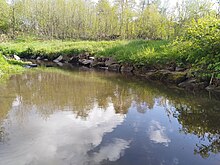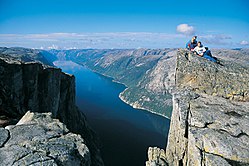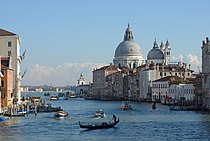| Name |
Description |
Regions/dialects
|
| Allt |
Stream |
Scottish Highlands[citation needed]
|
| Arm of the sea |
also sea-arm, used to describe a sea loch. |
|
| Arroyo |
A usually-dry bed of a steep-sided stream, gully, or narrow channel that temporarily fills with water after heavy rain. See also wadi. |
Southwest US
|
| Artificial lake or artificial pond |
see reservoir (impoundment). |
|
| Barachois |
A lagoon separated from the ocean by a sand bar. |
Canada
|
| Basin |
|
|
| Bay |
An area of water bordered by land on three sides, similar to, but smaller than a gulf. |
|
| Bayou |
A slow-moving stream or a marshy lake. |
Southern US
|
| Beck (stream) or Beck (gill) |
A small stream (esp. with a rocky bottom); creek.[5] |
Lincolnshire to Cumbria in areas which were once occupied by the Danes and Norwegians.[6]
|
| Bight |
A large and often only slightly receding bay, or a bend in any geographical feature. |
|
| Billabong |
an oxbow lake; a pond or still body of water created when a river changes course and some water becomes trapped. |
Located in Australia
|
| Boil |
see seep |
|
| Bog |
a type of wetland that accumulates peat due to incomplete decomposition of plant matter. |
|
| Bourne or Winterbourne |
a brook; stream; small, seasonal stream.[7][8] |
Chalk downland of southern England
|
| Broad |
A stationary inland body of fresh water |
Norfolk and Suffolk area; cf. The Broads
|
| Brook |
A small stream; a creek.[9][10] |
|
| Brooklet |
A small brook. |
|
| Burn |
A small stream; a brook.[11][12] |
Scotland and North East England.[13]
|
| Canal |
an artificial waterway, usually connected to (and sometimes connecting) existing lakes, rivers, or oceans.
|
| Channel |
the physical confine of a river, slough or ocean strait consisting of a bed and banks. See also stream bed and strait.
|
| Cove |
a coastal landform. Earth scientists generally use the term to describe a circular or round inlet with a narrow entrance, though colloquially the term is sometimes used to describe any sheltered bay. |
|
| Creek |
a (narrow) stream that is smaller than a river; a minor tributary of a river; brook.[19] |
Australia, Canada, New Zealand, United States
|
| Creek (tidal) |
an inlet of the sea, narrower than a cove.[24] |
Mainly British
|
| Dam |
A dam is a barrier that stops or restricts the flow of surface water or underground streams, or water reservoir resulting from placing such a structure. |
|
| Delta |
the location where a river flows into an ocean, sea, estuary, lake, or reservoir. |
|
| Distributary or distributary channel |
a stream that branches off and flows away from the main stream channel. |
|
| Drainage basin |
a region of land where water from rain or snowmelt drains downhill into another body of water, such as a river, lake, or reservoir.
|
| Draw |
a usually dry creek bed or gulch that temporarily fills with water after a heavy rain, or seasonally. See also wadi. |
|
| Dyke (UK) |
Either a narrow artificial channel off a river or broad for access or mooring, or a ditch (a water-filled drainage trench); not to be confused with Dyke (embankment) |
Used in The Broads
|
| Estuary |
a semi-enclosed coastal body of water with one or more rivers or streams flowing into it, and with a free connection to the open sea |
|
| Firth |
Various coastal waters, such as large sea bays, estuaries, inlets, and straits. |
Scottish
|
| Fjord (fiord) |
a narrow inlet of the sea between cliffs or steep slopes.[25] |
Scandinavian
|
| Gill or Ghyll |
a narrow stream or rivulet; brook; narrow mountain stream.[29] |
The north of England and Kent and Surrey influenced by Old Norse; The variant "ghyll" is used in the Lake District and appears to have been an invention of William Wordsworth.[30]
|
| Glacier |
a large collection of ice or a frozen river that moves slowly down a mountain. |
|
| Glacial pothole |
a giant's kettle. |
|
| Gulf |
a part of a lake or ocean that extends so that it is surrounded by land on three sides, similar to, but larger than a bay. |
|
| Harbor |
an artificial or naturally occurring body of water where ships are stored or may shelter from the ocean's weather and currents. |
|
| Hot spring |
a spring produced by the emergence of geothermally heated groundwater. |
|
| Impoundment |
an artificially-created body of water, by damming a source. Often used for flood control, as a drinking water supply (reservoir), recreation, ornamentation (artificial pond), or other purpose or combination of purposes. The process of creating an "impoundment" of water is itself called "impoundment." |
|
| Ice cap |
A body of frozen water less than 50,000 km2 not constrained by topographical features (i.e., they will lie over the top of mountains)
|
| Ice field |
A body of frozen water constrained by topographical features |
|
| Ice sheet |
A body of frozen water more than 50,000 km2
|
| Inlet |
a body of water, usually seawater, which has characteristics of one or more of the following: bay, cove, estuary, firth, fjord, geo, sea loch, or sound. |
|
| Kettle (or kettle lake) |
a shallow, sediment-filled body of water formed by retreating glaciers or draining floodwaters. |
|
| Kill |
a strait, river, or arm of the sea. |
used in areas of Dutch influence in New York, New Jersey and other areas of the former New Netherland colony of Dutch America
|
| Lagoon |
a body of comparatively shallow salt or brackish water separated from the deeper sea by a shallow or exposed sandbank, coral reef, or similar feature. |
|
| Lake |
a body of water, usually freshwater, of relatively large size contained on a body of land. |
|
| Lick |
a small watercourse or an ephemeral stream |
|
| Loch |
a body of water such as a lake, sea inlet, firth, fjord, estuary or bay. |
Scottish
|
| Mangrove swamp |
a saline coastal habitat of mangrove trees and shrubs. |
|
| Marsh |
a wetland featuring grasses, rushes, reeds, typhas, sedges, and other herbaceous plants (possibly with low-growing woody plants) in a context of shallow water. See also salt marsh. |
|
| Mediterranean sea (oceanography) |
a mostly enclosed sea that has a limited exchange of deep water with outer oceans and where the water circulation is dominated by salinity and temperature differences rather than winds |
|
| Mere |
a lake or body of water that is broad in relation to its depth. |
|
| Mill pond |
a reservoir built to provide flowing water to a watermill. |
|
| Moat |
a deep, broad trench, either dry or filled with water, surrounding and protecting a structure, installation, or town. |
|
| Mud puddle |
|
|
| Nant |
Stream |
Wales.[31]
|
| Ocean |
a major body of salty water that, in totality, covers about 71% of the Earth's surface. |
|
| Oxbow lake |
a U-shaped lake formed when a wide meander from the mainstem of a river is cut off to create a lake. |
|
| Phytotelma |
a small, discrete body of water held by some plants.
|
| Plunge pool |
a depression at the base of a waterfall. |
|
| Pool |
various small bodies of water such as a swimming pool, reflecting pool, pond, or puddle. |
|
| Pond |
a body of water smaller than a lake, especially those of artificial origin. |
|
| Port |
a maritime facility where ships may dock to load and discharge passengers and cargo. |
|
| Pothole |
see kettle |
|
| Puddle |
a small accumulation of water on a surface, usually the ground. |
|
| Reflecting pool |
a water feature usually consisting of a shallow pool of water, undisturbed by fountain jets, for a reflective surface. |
|
| Reservoir |
a place to store water for various uses, especially drinking water, which can be a natural or artificial (see lake and impoundment). |
|
| Rill |
a shallow channel of running water. These can be either natural or human-made. Also: a very small brook; rivulet; small stream.[32][33] |
|
| River |
a natural waterway usually formed by water derived from either precipitation or glacial meltwater, and flows from higher ground to lower ground. |
|
| Rivulet |
(UK, US literary) a small or very small stream.[34] |
Victorian era publications.[35]
|
| Roadstead |
a place outside a harbor where a ship can lie at anchor; it is an enclosed area with an opening to the sea, narrower than a bay or gulf (often called a "roads"). |
|
| Run |
a small stream or part thereof, especially a smoothly flowing part of a stream. |
|
| Salt marsh |
a type of marsh that is a transitional zone between land and an area, such as a slough, bay, or estuary, with salty or brackish water. |
|
| Sea |
a large expanse of saline water connected with an ocean, or a large, usually saline, lake that lacks a natural outlet such as the Caspian Sea and the Dead Sea. In common usage, often synonymous with the ocean. |
|
| Sea loch |
a sea inlet loch. |
|
| Sea lough |
a fjord, estuary, bay or sea inlet. |
|
| Seep |
a body of water formed by a spring. |
|
| Slough |
several different meanings related to wetland or aquatic features. |
|
| Source |
the original point from which the river or stream flows. A river's source is sometimes a spring. |
|
| Shoal |
a natural submerged ridge, bank, or bar that consists of, or is covered by, sand or other unconsolidated material, and rises from the bed of a body of water to near the surface.
|
| Sound |
a large sea or ocean inlet larger than a bay, deeper than a bight, wider than a fjord, or it may identify a narrow sea or ocean channel between two bodies of land. |
|
| Spring |
a point where groundwater flows out of the ground, and is thus where the aquifer surface meets the ground surface |
|
| Strait |
a narrow channel of water that connects two larger bodies of water, and thus lies between two land masses. |
|
| Stream |
a body of water with a detectable current, confined within a bed and banks. |
|
| Stream pool |
a stretch of a river or stream in which the water is relatively deep and slow moving. |
|
| Streamlet |
a small stream; rivulet.[36] |
|
| Subglacial lake |
a lake that is permanently covered by ice and whose water remains liquid by the pressure of the ice sheet and geothermal heating. They often occur under glaciers or ice caps. Lake Vostok in Antarctica is an example. |
|
| Swamp |
a wetland that features permanent inundation of large areas of land by shallow bodies of water, generally with a substantial number of hummocks, or dry-land protrusions. |
|
| Syke[37] |
Stream |
Scottish Lowlands and Cumbria
|
| Swimming pool |
an artificial container filled with water intended for swimming. |
|
| Tank |
(or stock tank, Texas) an artificial pond, usually for watering cattle or other livestock.[38] |
|
| Tarn |
a mountain lake or pool formed in a cirque excavated by a glacier. |
|
| Tide pool |
a rocky pool adjacent to an ocean and filled with seawater. |
|
| Tributary or affluent |
a stream or river that flows into the main stem (or parent) river or a lake. |
|
| Vernal pool |
a shallow, natural depression in level ground, with no permanent above-ground outlet, that holds water seasonally. |
|
| Wadi |
a usually-dry creek bed or gulch that temporarily fills with water after a heavy rain, or seasonally |
Located in North Africa and Western Asia. See also arroyo (creek).
|
| Wash |
a usually dry creek bed or gulch that temporarily fills with water after a heavy rain, or seasonally. See also wadi. |
|
| Wetland |
an environment "at the interface between truly terrestrial ecosystems and truly aquatic systems making them different from each yet highly dependent on both".[39] |
|





